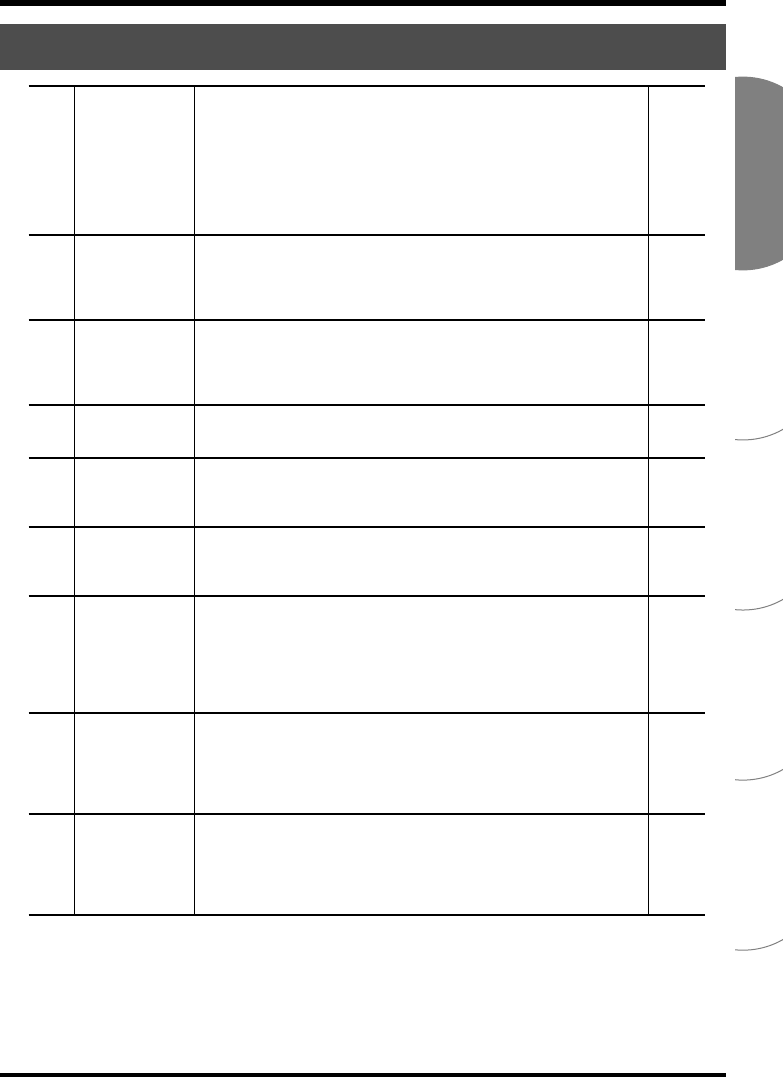
EnglishDeutschFrançaisItalianoEspañol
47
Using effects
Effect list
01
Easy EQ
Eleven settings are provided for use with styles such as rock, pop, or
dance. Each setting modifies the tonal character (frequency response)
appropriately for the selected style of music. For example, the Rock
setting boosts the low and high frequency ranges to give the sound
greater impact. The Pop setting makes it easier to hear the range in
which the melody is usually played. The Vocal setting makes the lyrics
more audible. The Flat setting simply outputs the sound without any
change in tonal character.
Internally, this effect uses a ten-band graphic equalizer.
p. 49
02
For Speech
This effect is appropriate for material that is mainly a speaking voice,
such as conversation or dialog. It clarifies the voice, and also reduces
the sibilance (unpleasant exaggeration of sounds beginning with “s”)
that can occur when recording with a microphone.
Internally, this effect combines a de-esser and an enhancer.
p. 49
03
Voice Perform
This effect can completely transform the character of a voice by modi-
fying the pitch of the sound. You can use the provided settings to cre-
ate comical voices, low monster-like voices, or voices that have a
“springy” character.
Internally, this combines a pitch shifter and a delay.
p. 49
04
Editable EQ
This is a ten-band graphic equalizer with adjustable gain. For each
band, you can adjust the gain in a range of -12 dB– +12 dB to modify
the tonal character of the sound.
p. 49
05
Noise Reduc-
er
This effect reduces the “hissing” or “rushing” background noise that
may be heard during silent portions of a recording, or the hiss that is
often heard on an analog record or cassette tape.
Internally, this combines a noise gate and a notch filter.
p. 49
06
Hum Noise
Cut
This effect reduces the low-pitched “hum” that can occur when re-
cording from a microphone or when a motorized device is located
nearby.
Internally, this is a notch filter.
p. 50
07 Reverb
When you listen to sound, you are hearing not only the sound that
comes directly from the source to your ears, but also the sound that re-
flects off the floor and walls. These reflections are called “reverbera-
tion” (reverb), and their character will vary depending on the size of
the room and the material of which the walls are constructed.
This effect adds simulated reverberation to the original sound, pro-
ducing a natural-sounding impression of spaciousness.
p. 50
08
Int-Mic Rec.
This effect modifies the character of the sound recorded from the in-
ternal mic or a miniature condenser mic connected to the mic input
jack, giving it the character of sound recorded from a larger mic. It can
simulate the characteristics of famous mics used in recording studios,
giving your sound a professional touch.
This effect is particularly useful when applied during recording.
p. 50
09 Ext-Mic Rec.
This effect modifies the character of the sound recorded from a typical
small dynamic mic connected to the mic input jack, giving it the char-
acter of sound recorded from a larger mic. It can simulate the charac-
teristics of famous mics used in recording studios, giving your sound
a professional touch.
This effect is particularly useful when applied during recording.
p. 50
R-1_egfis1.book 47ページ 2005年11月11日 金曜日 午後5時13分


















